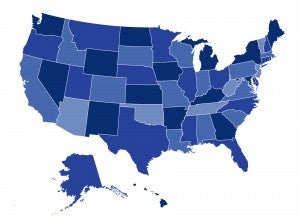
Whether or not small employers will begin self-funding in greater numbers as the Affordable Care Act is fully implemented continues to be a hot topic. In just the past few weeks alone, it’s been covered by major newspapers, including the Wall Street Journal and New York Times, and trade press, like Modern Healthcare.
Earlier this year, I and my colleagues Kevin Lucia and Sabrina Corlette wrote a paper published by The Urban Institute and the Robert Wood Johnson Foundation, digging into this question. We spoke with approximately 50 expert informants across 10 states participating in the Robert Wood Johnson Foundation’s monitoring and tracking project (Alabama, Colorado, Maryland, Michigan, Minnesota, New Mexico, New York, Oregon, Rhode Island, and Virginia). What we uncovered is that no one really knows what is going to happen and no one is actually watching this market systematically at the state level to see if the anecdotes covered by the press actually add up to anything. None of the 10 states reported that they were currently monitoring how frequently stop-loss coverage is sold to small groups or the number of small employers currently covered by stop-loss policies and only one state – Rhode Island – indicated that it had any plans to do so in the future. (And, as we’ve noted previously on CHIRblog, the federal government doesn’t have much data on this market either.)
The good thing that may come out of the media coverage of this issue is that it looks like it might be encouraging states to start paying more attention to the sale of stop-loss policies small groups. When we spoke with state officials for our paper this winter, they consistently reported that further state action was unlikely in the near future. While they appreciated the concern that a significant increase in self-funding could destabilize the small group market and undermine SHOP exchanges, they were too consumed with implementation of exchanges and the 2014 market reforms to focus on stop-loss. However, this spring two states that we profiled in our paper have in fact taken recent action in this area:
Rhode Island
On Tuesday, Rhode Island’s House and Senate passed legislation (H.B. 5459/S.B. 666) regulating the sale of stop-loss insurance.
The legislation, which is currently before the governor, establishes minimum attachment points for stop-loss policies. The minimum specific attachment point – which represents the minimum dollar amount where the stop-loss issuer begins paying for claims incurred by a covered individual and the employer’s liability ends – is set at $20,000 while the minimum aggregate attachment point – which does the same at the group level – is set at 120% of expected claims. These levels align with the minimum attachment points set by the NAIC its 1995 model act (which themselves have been subject to much debate in the past year over whether or not they should be raised to reflect increasing health care costs).
Colorado
In May, the governor of Colorado signed H.B. 13-1290, the Modernize Stop-Loss Health Insurance Act, into law. This law has three major components:
First, for stop-loss policies sold to employers with 50 or fewer employees, it raises the state’s minimum specific attachment point from $15,000 to $20,000 and prohibits aggregate attachment points below $20,000, as well. (As we reported, Colorado already applied minimum aggregate attachment point of 120% to the small group market.)
Second, it institutes a number of important consumer protections for stop-loss policies sold to small employers. As we discussed in our report, common criticisms against self-funding by small employers were that small employers often do not understand of all the ins and outs of stop-loss policies and are unaware of their liability even when insured. The Colorado law prohibits a practice known as “lasering” (identifying individuals in the group and either excluding them from coverage or varying their specific attachment point level to protect the issuer from higher risk employees or dependents). It also requires stop-loss issuers to make a number of disclosures to insured groups, including the policy’s renewability provisions, any limitations on coverage, and the employer’s maximum liability for claims incurred before but not processed until after the termination of the policy.
Last, but certainly not least, it sets robust data reporting requirements on stop-loss issuers. Our research found an incredible dearth of data on self-funding by small employers. Beginning this year and through calendar year 2018, stop-loss insurers will be required file with the Colorado insurance commissioner an annual report detailing the following important data points:
- The total number and average group size of stop-loss policies sold to small employers, broken down by groups of 10 or fewer full-time equivalent (FTE) employees, 11-25 FTEs, 26-50 FTEs, and 51-100 FTEs;
- The number of lives covered in Colorado and the median and mean attachment points for each clusters listed above;
- The employer’s source of prior coverage, including whether they were previously insured through the state health insurance exchange, Connect for Health Colorado; and
- The smallest group size covered and insurer minimum group size requirements.
In researching our paper, it was clear that size makes a big difference in an employer’s likelihood to self-fund. Generally, informants felt that groups with 51 or more employees would be much more likely to turn to self-funding in response to the ACA’s new market rules and ever increasing health care costs than groups with 50 or fewer employees. To the extent that these smaller sized groups do self-fund, some informants predicted that it would be primarily limited to groups with at least 30 or 35 employees or groups that were larger when they began self-funding.
We hope the Colorado Department of Insurance publishes their data so that we can get a better idea of what is happening on the ground there and perhaps motivate a few more states to follow suit. In the meantime, CHIRblog will continue to keep you apprised of key developments in this mysterious market as we come across them.


1 Trackback or Pingback